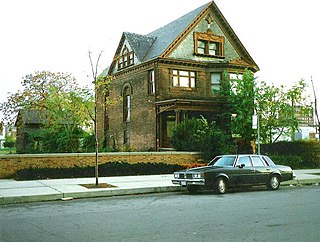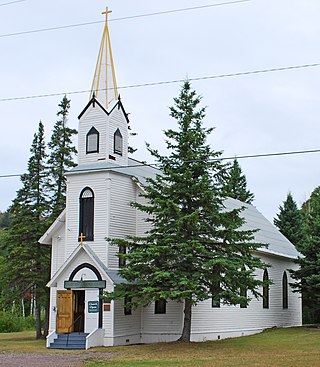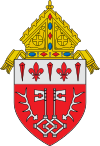
The Second Baptist Church, located at 441 Monroe Street within Greektown in Detroit, Michigan, is the oldest African-American church in the Midwestern United States. It was designated a Michigan State Historic Site in 1974 listed on the National Register of Historic Places in 1975.

Fort Michilimackinac was an 18th-century French, and later British, fort and trading post at the Straits of Mackinac; it was built on the northern tip of the lower peninsula of the present-day state of Michigan in the United States. Built around 1715, and abandoned in 1783, it was located along the straits that connect Lake Huron and Lake Michigan of the Great Lakes of North America. A reconstruction of the fort is preserved as the main feature of Colonial Michilimackinac Historic State Park.

St. Peter Cathedral is a large Roman Catholic cathedral located on Baraga Avenue in Marquette, Michigan. As the mother church of the Diocese of Marquette, it is one of the most notable marks of Catholic presence in the Upper Peninsula. The cathedral was listed on the National Register of Historic Places in 2012.

Assinins is a historic district consisting of several buildings that were originally a school and orphanage, located in Assinins, Michigan. The district was listed on the National Register of Historic Places in 1972.

St. John's Episcopal Church is an antebellum-era church located at 2326 Woodward Avenue in Downtown Detroit, Michigan. It is the oldest church still standing on Woodward Avenue, an area once called Piety Hill for its large number of religious buildings. The church was listed on the National Register of Historic Places in 1982 and designated a Michigan State Historic Site in 1987.

The Prayer Temple of Love Cathedral is located at 12375 Woodward Avenue in Highland Park, Michigan. It was built in 1929 as the Grace Evangelical Lutheran Church, and was listed on the National Register of Historic Places in 1982.

The Our Lady of the Rosary Church is a Roman Catholic church located at 5930 Woodward Avenue in Detroit, Michigan. It was originally built as St. Joseph's Episcopal Church – from 1893 to 1896 – and is a historic Romanesque Revival church complex. It was added to the National Register of Historic Places on August 3, 1982.

The Historic Trinity Lutheran Church is a church located in downtown Detroit, Michigan. It occupies the Trinity Evangelical Lutheran Church complex, located at 1345 Gratiot Avenue. It was designated a Michigan State Historic Site in 1981 and listed on the National Register of Historic Places in 1983. Its current pastor is Rev. Darryl L. Andrzejewski.

The Sugar Hill Historic District is a historic district in Detroit, Michigan. It contains 14 structures located along three streets: East Forest, Garfield, and East Canfield, between Woodward Avenue on the west and John R. on the east. The district was listed on the National Register of Historic Places in 2003.

The Robert M. and Matilda (Kitch) Grindley House was a private residence located at 123 Parsons Street in Detroit, Michigan. It was listed on the National Register of Historic Places in 1997, but was subsequently demolished.

Christ Church Detroit is an Episcopal church located at 960 East Jefferson Avenue in Detroit, Michigan. It is also known as Old Christ Church, Detroit. It is the oldest Protestant church in Michigan still located on its original site. It was designated a Michigan State Historic Site in 1970 and listed on the National Register of Historic Places in 1971.

The Church of Our Saviour, also known as the Church of Our Saviour at Mission Farm, the Mission of the Church of Our Saviour, and the Josiah Wood Jr. Farm, is a historic Episcopal church and farm complex located at 316 Mission Farm Road, in Killington, Vermont. The church is a Gothic Revival stone building, built in 1894-95 of Vermont granite. In addition to the church, the 170-acre (69 ha) Mission Farm property includes a c. 1817 farmhouse, a guest and retreat house, a vicarage, a bakery and agricultural buildings. On October 29, 1992, it was added to the National Register of Historic Places. Currently, The Rev. Lisa Ransom is the Executive Director of Mission Farm and Vicar of The Church of Our Saviour.

The Church of the Assumption is an historic Carpenter Gothic style Roman Catholic church located on US 41, 400 feet east of M-26 in Phoenix in Houghton Township, Michigan. It is also known as the Phoenix Church. The church was listed on the National Register of Historic Places in 2000.

The Grosse Pointe Memorial Church (GPMC) is a church located at 16 Lake Shore Drive in Grosse Pointe Farms, Michigan, USA. it is a member of the Presbyterian Church, USA (PCUSA). It was designated a Michigan State Historic Site in 1990 and listed on the National Register of Historic Places in 1993.

Saint Mary of Good Counsel Catholic Church is an active church building located at 305 Division Street in the city of Adrian in Lenawee County, Michigan. It was listed on the National Register of Historic Places on February 24, 1983. It is also designated as a Michigan State Historic Site.

Saint Ignatius Loyola Church is a church located at 703 East Houghton Avenue in Houghton, Michigan. The church was designated a Michigan State Historic Site in 1977 and listed on the National Register of Historic Places in 1987.

The Old US 41–Backwater Creek Bridge is a bridge located on an abandoned section of US Highway 41 (US 41) over Backwater Creek in Baraga Township, Michigan. It was listed on the National Register of Historic Places in 1999.

St. Francis Solanus Mission is a historic mission on W. Lake Street in Petoskey, Michigan. It is the only existing building in the Arbre Croche district dating from the time of Bishop Frederic Baraga, and is the oldest building still standing in Petoskey, as well as one of the oldest in northern lower Michigan. The mission was added to the National Register of Historic Places in 1972.

The Unitarian Universalist Church is a historic church building at 100 N. State Street in Ann Arbor, Michigan. It was listed on the National Register of Historic Places in 1978.

The Philetus S. Church House is a private house located on North Shore Road, 1 mile (1.6 km) southeast of Payment Settlement on Sugar Island, Michigan. The building is the last structure from Church's Landing, a mid-19th century trading post and steamboat stop. It was listed on the National Register of Historic Places in 1982.























